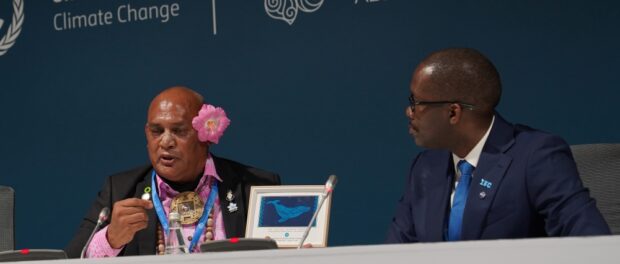| The voices of the Indigenous Peoples of the Iwokrama Forest, one of the last pristine rainforests in the world, echoed through the hallways of COP29 in Azerbaijan today, more than 6,500 miles from their native Guyana.The official COP29 side event, Indigenous and local knowledge systems for Climate Action: Delivering Together a Resilient future for All, was co-hosted by Namibia, Seychelles, and the Commonwealth Secretariat. Attendees witnessed the wisdom of the Iwokrama through a stunning short film, which showcased the power of indigenous knowledge, especially when combined with Western science, to support sustainable livelihoods and economies.Titled Take only what you need: The success story of the Iwokrama Forest, the film was produced by the Commonwealth Secretariat in partnership with the Iwokrama International Centre for Rain Forest Conservation and Development (IIC). The film’s main character, Michael Williams, the Toshao or chief of Guyana’s Annai Central region, inspired the film’s core message.In the film, he says:“Take what you need and leave the rest for future generations.”Since 1996, the Commonwealth Secretariat has worked with the Government of Guyana to support the IIC. This collaboration is underpinned by the Commonwealth’s 2022 Living Lands Charter, which aims to accelerate integrated and sustainable land management in line with the three Rio conventions on climate change, biodiversity and land degradation.Indigenous Wisdom: A Climate Crisis SolutionUnveiling the film, the Commonwealth Secretary-General, the Rt Hon Patricia Scotland KC, highlighted indigenous knowledge as vital to unlocking solutions to the climate and biodiversity crisis. She said:“The Commonwealth Secretariat premiered this film at COP29 so delegates could hear the voices of Guyana’s Indigenous Peoples and see the ground-breaking Iwokrama Forest model’s success.“The incredible progress of the last 200 years has come at an unsustainable cost. For a viable future, we need to acknowledge that Indigenous Peoples have managed their societies more sustainably. Justice, empowerment and solidarity with Indigenous Peoples will unlock a genuinely prosperous future for us all.”Sonia Latchman, Vice Chair of the National Toshaos Council in Guyana, spoke proudly of the Iwokrama film that had been broadcast to the COP side event moments earlier. She said:“The video we saw says it all – in Guyana we have the solution to the climate crisis, and we have a very good model for other countries to follow as it relates to diversity in Guyana, from rainforests, to savannahs, and wetlands.“Indigenous Peoples are very important. Our voices must be heard, our rights respected, and we must be invited to the table. Guyana should be an example because our model is working – not just for all Indigenous Peoples but for all citizens back home.”Anita Soina, a Maasai environmentalist from Kenya, spoke of the importance of utilising the experience and culture of communities as part of the fight to tackle the climate crisis:“Most of the time Indigenous knowledge is not really acknowledged, but we have really witnessed the importance of knowledge from our elders. Because of globalisation we are losing our culture and our knowledge, so we organise activities where we allow young people to have conversations with our elders.“It’s important that young people are inculcated with knowledge, and we need a lot of support for indigenous and locally led projects so that it can continue to motivate.”Historically, Indigenous Peoples and local communities have largely been excluded from climate negotiations despite their deep knowledge of and connection to nature. As a result, their concerns, knowledge and insights as stewards of nature, climate and land have been excluded or compromised.Over the past few years, calls have grown across several Commonwealth countries to integrate local knowledge and wisdom for elevating Indigenous Peoples’ role in climate and biodiversity negotiations.The Living Lands Charter complements the ongoing work of the Commonwealth Climate Finance Access Hub (CCFAH), the Apia Commonwealth Ocean Declaration, and the Commonwealth Sustainable Energy Transition (CSET). This is underpinned by the UN Declaration on the Rights of Indigenous People and the principle that they should have Free Prior and Informed Consent (FPIC) about decisions that affect them.The Iwokrama film also complements the Forest Carbon Toolkit, launched by the Commonwealth Secretariat at COP29. The toolkit, which includes case studies from Guyana and Rwanda, provides a roadmap to access funding through the voluntary carbon market, while protecting the lives and livelihoods of Indigenous Peoples, local communities, and landowners. Watch the short film: Take only what you need: The success story of the Iwokrama ForestNotes to EditorsThere are about half a billion Indigenous People in the world, encompassing a vast tapestry of cultural diversity from the Bejas in Namibia, the Maasai of East Africa to the Aboriginal People of Australia.In terms of conventional economics, Indigenous Peoples are disproportionately represented among the poorest segments of society. However, regarding natural capital, indigenous people are the world’s wealthiest.Indigenous People represent 5% of the global population, yet they steward and are dependent on over 20% of the earth and over 80% of the planet’s remaining biodiversity.About the CommonwealthThe Commonwealth is a voluntary association of 56 independent and equal sovereign states. Our combined population is 2.5 billion, of which more than 60 per cent is aged 29 or under.The Commonwealth spans the globe and includes both advanced economies and developing countries. Thirty-three of our members are small states, many of which are island nations.The Commonwealth Secretariat supports member countries to build democratic and inclusive institutions, strengthen governance and promote justice and human rights. Our work helps to grow economies and boost trade, deliver national resilience, empower young people, and address threats such as climate change, debt and inequality.Member countries are supported by a network of more than 80 intergovernmental, civil society, cultural and professional organisations. |

Leave a comment
You must be logged in to post a comment.